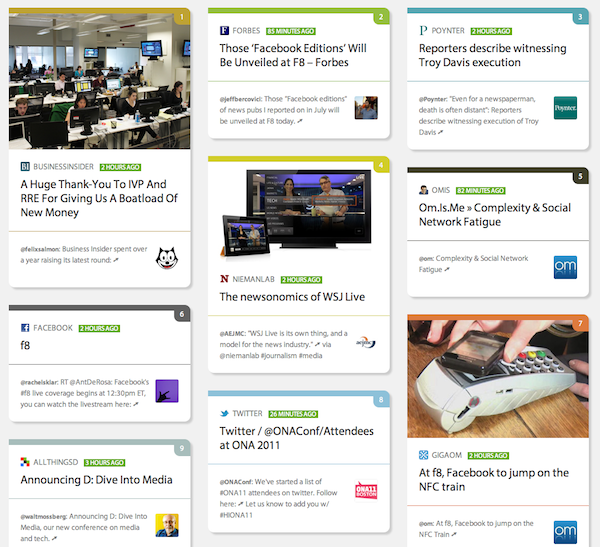
It was one month ago today that we launched (as part of our redesign) Fuego, our heat-seeking Twitter bot. Fuego scans through the future-of-news sector of the Twitterverse to identify the stories that journalists, techies, and thinkers are reading and talking about right now.
Well, we believe in iterative design, so I’m very happy today to unveil a new version — call it Fuego 2.0. It’s live now — go check it out.
There are three major improvements worth noting:
The most obvious change is a very different look. For each story, we now give you a rich set of information, including its headline, its source, an image (if available), and a sample tweet linking to it. It arrays the top links in a tile/card style, making them much more scannable and visually interesting.
(This is done via the magic of Embedly, a Cambridge startup with an API that converts simple URLs into rich metadata, including headlines and images. It’s a very useful product for a particular set of needs; check them out.)
There are now three distinct lenses through which to view Fuego. You can pick among them using the buttons on top of the page.
The default Fuego view looks at new links from the past 24 hours. More recent links are given more weight than older ones. It’s the best way to get a quick glance at the day’s conversation.
The “fresh” view of Fuego looks at only new links from the past four hours. If you’re checking Fuego multiple times a day, you’ll probably want to use this view — although because the time span is shorter and Fuego has less data to work with, the links may be less focused on journalism issues at times.
Finally, if you want to take the long view, check out Fuego’s week view, which summarizes the most popular links of the past seven days. It’s a great way to catch up if you’ve been away from the future-of-news world for a few days.
The day view remains the default, and we think it’ll hit a sweet spot for most users: Important news will stick around for longer, and they’ll tend to be more focused on journalism issues. But the fresh view is pretty great to, changing all the time, but at the expense of being a little less focused. (You’ll usually see a little news from the broader world poking through in the four-hour view.) Try them all out and see which ones you like.
The first version of Fuego gave you the 10 top links of the moment. Now, with inflation and all, we give you 20 in each view.
We use Fuego at the Lab all the time — it’s like being on Twitter all day long without having to be on Twitter all day long. It’s a great story-discovery tool, and we hope you like it. And we’re not done yet! Look for new Fuego features in the coming weeks.